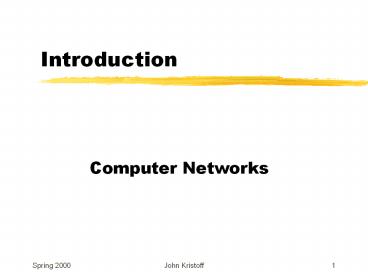Computer Networks - PowerPoint PPT Presentation
1 / 29
Title:
Computer Networks
Description:
Introduction Computer Networks Motivation and Scope Computer networks and internets: an overview of concepts, terminology and technologies that form the basis for ... – PowerPoint PPT presentation
Number of Views:158
Avg rating:3.0/5.0
Title: Computer Networks
1
Introduction
Computer Networks
2
Motivation and Scope
- Computer networks and internets an overview of
concepts, terminology and technologies that form
the basis for digital communication in private
corporate networks the the global Internet.
3
Motivation for Networks
- Information Access
- Sharing of Resources
- Facilitate Communications
4
What a Network Includes
- Transmission hardware
- Special-purpose hardware devices
- interconnect transmission media
- control transmission
- run protocol software
- Protocol software
- encodes and formats data
- detects and corrects problems
5
What a Network Does
- Provides communication that is
- Reliable
- Fair
- Efficient
- From one application to another
6
What a Network Does continued
- Automatically detects and corrects
- Data corruption
- Data loss
- Duplication
- Out-of-order delivery
- Automatically finds optimal path from source to
destination
7
(No Transcript)
8
(No Transcript)
9
Network Topologies
10
Transmission Media
- Wireline
- String
- Garden Hose
- Copper
- Twisted Pair
- Coax
- Optical Fiber
- Wireless
- Sound
- Light and mirrors
- Infrared
- RF
- Microwave
11
Network Scope
- Local Area Network (LAN)
- Metropolitan Area Network (MAN)
- Wide Area Network (WAN)
12
(No Transcript)
13
Multiplexing
14
Communication Modes
- Simplex
- Half-duplex
- Full-duplex
15
Connection-oriented versus Connectionless
- Connection Setup
- Data Transfer
- Connection Termination
- Data Transfer
16
Circuit Switching versus Packet Switching
- Dedicated
- fixed bandwidth
- route fixed at setup
- idle capacity wasted
- network state
- Best Effort
- end-to-end control
- multiplexing technique
- re-route capability
- congestion problems
17
Examples
- Public Switched Telephone Network
- Internet
- Postal Service
- Train
- Car and highway system
18
Standards
- Hardware
- Software
- Protocols
- Advantages and Disadvantages
- Proprietary, De Facto, De Jure
- Standards Bodies
- IETF, IEEE, OSI, ANSI, ATM Forum, etc.
19
Protocols
- Rules, standards and etiquette
- Metric System
- English
- Dinner party
- Morse Code
- TCP/IP
- HTML
20
Layering
21
Headers, Data and Trailers
22
Encapsulation
23
ISO OSI Reference Model
- 7 Application Layer
- 6 Presentation Layer
- 5 Session Layer
- 4 Transport Layer
- 3 Network Layer
- 2 Data link Layer
- 1 Physical Layer
24
Interfaces and Services
- PDUs
- SDUs
- SAPs
- Peer communications
- Service Primitives
- etc... read Tanenbaum 1.3.3 and 1.3.5
25
TCP/IP Model
- 5 Application Layer
- 4 Transport Layer
- 3 Network Layer
- 2 Data link Layer
- 1 Physical Layer
26
TCP/IP versus OSI
- "Rough consensus and running code?
- Simplicity
- Time to market
- Availability
27
Network Classification
- Physical medium copper, fiber, wireless
- Scope LAN, MAN, WAN
- Topology bus, star, ring, mesh
- Switching style circuit, packet
- Application voice, data, video
- Protocol IP, OSI, Ethernet, ATM
- Transmission rate 10Mb/s, Gigabit
28
Terms I (we) Often Use
- Frames think data link layer
- Packets think network layer
- Datagrams think IP
- Segments think TCP
- Cells think ATM
- Layer ltxgt refer to reference models
29
The End-to-End Argument
- "End-to-End Arguments in System Design?
- J.H. Saltzer, D.P. Reed, and D.D. Clark
- http//web.mit.edu/Saltzer/www/publications/

